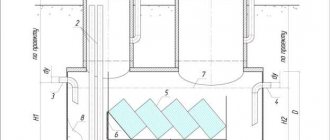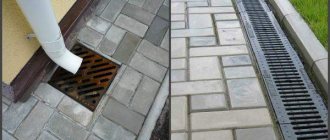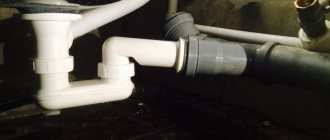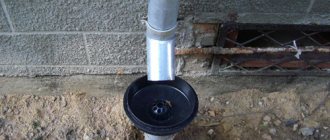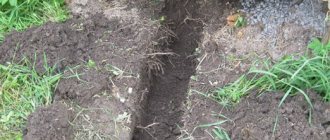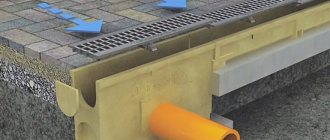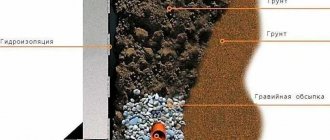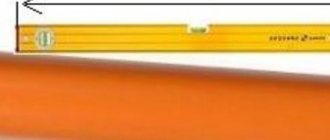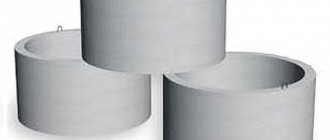Drainage of rainwater away from the house is an important component that must be taken into account when planning and carrying out construction work. To do this, rainwater inlets for storm drainage are installed under the drainpipes, discharging water outside the site into drains or containers for further use for irrigation and other household needs.
If a rainwater drainage system was not installed during the construction of a house or cottage and the need arose for its construction, such a structure is quite easy to make with your own hands without the help of hired workers. To do this, you should know the main types of storm sewer systems, their materials of manufacture and design, as well as installation rules when carrying out installation work yourself.
Rice. 1 Storm drains - examples of use on the site
How to choose a rainwater inlet for storm drainage
When choosing the right type of rainwater inlet for storm drainage, you need to take into account various factors, which, with the right approach, will provide you with long service life and reliability.
The most important of these factors are:
- intensity and amount of precipitation on the site, climatic conditions;
- storm drainage area;
- terrain;
With the correct calculation of these features of your site, you will be able to select the desired type of rainwater inlet itself.
For the backyard of a small private house, you can choose a rainwell that is lighter in weight and design, but if the climatic conditions are rainy and there is a lot of precipitation at different times of the year, then it is better to choose a cast iron option.
It will be able to withstand heavy loads and hold a lot of debris and leaves so that they do not clog underground sewer pipes.
Design features of rainwater inlets for storm drainage
All types of rainwater inlets differ in that they have different weights and depths. A standard rainwater inlet has a depth of about 40 centimeters and is light in weight, but if the material for its manufacture is cast iron, then the weight is much greater.
The rain inlet itself can be sold either separately or in a set with other elements for it.
The complete set consists of:
- the storm water inlet itself;
- baskets for rainwater inlets of different sizes;
- partitions - siphon;
- external grille.
All these elements may vary in quality and price. They are selected depending on the choice of the storm water inlet itself.
You can see the standard kit in the picture below.
The grid for point catchment can also be made of materials of different quality; its choice depends on the load that will be subsequently placed on the grid.
Materials for rainwater inlets: which is better, cast iron or plastic?
Previously, storm water inlets were made only of concrete or cast iron, but now another modification has been added to them - plastic storm water inlets for storm drainage.
At first glance, it may seem that it is better to choose cast iron material, as it is stronger.
But modern technologies make it possible to make the design of a plastic rainwater inlet highly durable and reliable.
The advantages of plastic materials are that they are light in weight and easy to install, protected from corrosion and external mechanical and chemical influences.
If you are still afraid that it will not withstand the load, then in the kit you can take a grate made of cast iron or other metal, this will reliably strengthen and protect the rain inlet.
You can see an example of a plastic point water collector in the image below.
The size of a standard plastic water collector for a home will be 300x300x300. You can also use this type of water collector as an independent collector well, since plastic rainwater inlets have the ability to install several layers, stacking them on top of each other to the desired height.
Cast iron rainwater inlets are most often used either on roads where vehicles frequently travel, or in places where water constantly accumulates.
We can also say that a cast iron drain can withstand a weight of about 90 tons, it is suitable for places with constant traffic and heavy traffic, and can withstand huge amounts of wastewater.
You can see what a cast iron drain looks like below.
Such a storm inlet can be quite large in size, this is suitable for the highest loads and will ensure the reliability of the storm sewer.
About each material separately
The technical characteristics of different materials cannot completely coincide, so the advantages and disadvantages of finished products are completely different. The elements are mainly made from cast iron, concrete or plastic. All of them are able to withstand different loads.
Correct location of the collection point relative to the drainpipe
Concrete structures
Almost every developer has the opportunity to buy a storm drainage inlet made of concrete. There are a great many options for such designs. Some owners of suburban areas make them themselves.
Drawing with dimensions of a concrete water collection tank
Concrete products are resistant to moisture, so they are ideal for collecting precipitation. They can be successfully operated for decades under high load. They should be chosen if heavy equipment will be regularly moving around the site.
Concrete structure with galvanized grating
Cast iron products
Most cast iron models are used in the construction of roads to drain sediment from roadways and sidewalks. DB2 rainwater inlets, which are widely used, are excellent for these purposes. In individual construction, less massive structures are used.
This is what the cast iron model db1 looks like
In suburban areas, models are usually installed with a width of 470 mm and a length of 695 mm. The products are characterized by a high level of wear resistance, which is why they attract many developers. Cast iron storm inlet grates are simply inserted into the inside of the block without additional fasteners.
Plastic elements
In current conditions, plastic products are most widespread. They allow not only to receive precipitation, but can also be used as inspection wells, since they can be placed on top of each other.
The structure is made of plastic
The advantages of plastic rainwater inlets are as follows:
- light weight greatly simplifies the installation of elements and transportation to the future installation site;
- plastic is a durable and weather-resistant material, so products made from it last a long time;
- thanks to the smooth surfaces, the process of cleaning structures does not cause difficulties;
- storm sewer pipelines can be installed without the use of additional fasteners;
- Installing the elements is relatively simple, so there are usually no problems when doing the work yourself.
Components for plastic products
The process of installing a plastic analogue under a drainpipe
Cast iron storm water inlets
The types and parameters of rectangular rainwater inlets made of cast iron are regulated by GOST 3634-99, which divides all products into the following categories:
- D – small storm water inlets weighing no more than 30 kg. and a rated load of up to 15 kilonewtons (kN), which in kilograms is equal to 1500 kg.
- DB1, DB2 - large storm water inlets with a total weight of about 50 kg. and 80 kg. Accordingly, they are installed on city highways and vehicle parking lots, holding a load of up to 12,500 kg.
- DM1, DM2 - mainline type models with a rated load of up to 25,000 kg, have a mass of 60 and 100 kg. Accordingly, they are used on highways with heavy traffic.
- DS1, DS2 - super-heavy modifications, designed to hold a nominal weight of 40,000 kg, product weight of 80 and 130 kg. Accordingly, they are used in areas of high loads (airfields, ship docks).
In addition to the rectangular products specified in the standard, the industry produces round varieties marked DK weighing about 100 kg, withstanding a rated load of about 15,000 kg.
Rice. 7 Cast iron drainage systems - examples of location
Cast iron structures have the following features:
- High drainage capacity due to the presence of wide cross-section grooves, ensuring the drainage of significant volumes of water.
- Durability to withstand significant loads of heavy vehicles.
- Long period of technical operation, which does not require frequent and complex maintenance of the drainage unit.
- High resistance to aqueous environments when the cast iron surface is coated with special corrosion-resistant components
- Environmental cleanliness and safety for people.
- Cost acceptable to the consumer.
- The large mass of the product makes its installation difficult, requiring the installation of a high-strength reinforced concrete well.
- Gratings and frames made from cheap, untreated cast iron are highly susceptible to corrosion.
- Due to widespread cases of theft of ferrous and non-ferrous metals, many devices are equipped with special fasteners consisting of elements that lock the grille.
In individual areas, such structures are rarely used due to their large dimensions and weight; for private areas, DB1 products with overall dimensions of 695x470x120 mm are most suitable.
Rice. 8 Plastic rainwater inlets for storm sewers - modifications
Features of installation of surface drainage systems
Often, on an individual plot near a private house, it is necessary to collect water from paving slabs, if the slope does not allow it to be drained outside the plot, and direct it to a drainage well or outside the plot. For these purposes, surface systems are used, consisting of rainwater inlets and trays made by hand from concrete, or factory products made of plastic, concrete or polymer concrete.
It is easier and faster to assemble surface drainage from semicircular trays made of concrete or plastic; work is carried out in the following order:
- They draw up a drainage diagram linked to the site plan, indicating the slopes and direction of water movement along the trays.
- Prepare the necessary tools, the main ones of which are a building level, an angle grinder, a rubber hammer, a spatula, and a bayonet shovel.
- A drainage hole is made in the concrete polymer sand catcher and a place is prepared for installing trays, observing the required slopes. To do this, mark a line with a cord along which you dig a ditch of the required depth so that there is a free space of about 10 cm on the bottom and sides of the tray.
- The trays are laid out along dug channels, starting from the highest point of the drain and connecting to each other; if necessary, use a grinder for adjustment.
- Place a concrete pad at the bottom of the pit and lower the trays onto it, checking the slope with a level and the straightness of the direction with a previously stretched cord. The position is adjusted using a rubber hammer.
- The joints in concrete-polymer trays are sealed using the sealant included in the kit; in the last section, a plug is glued to the end.
- After the concrete has hardened, the system is covered with gratings, then the channels are lined with paving slabs; during installation, the depth of the grating should be maintained at 3 - 5 mm. below the surface level of the paving lining.
Rice. 14 Isoline map of precipitation intensity depending on the area
Criteria for choosing a water receiver
When selecting a receiver for a storm sewer, pay attention to its characteristics taking into account the proposed storm drainage system, which is designed based on specific data:
- the maximum amount of precipitation on a site or territory - this parameter can be found in the SNiP reference book, it also contains information regarding the maximum amount of snow cover in winter;
- moisture absorption coefficient depending on the type of coating, for example, for crushed stone it is 0.4, and for roofing - 1.0;
- the size of the plot or territory from which drainage is planned.
In accordance with the above indicators, the type of storm sewer system is determined. When choosing it, the climatic conditions and intensity of precipitation in the region, the type of soil in the area and the maximum permissible load are also taken into account.
In cases where the consumer is not satisfied with the price of the product, but it is necessary to drain wastewater from the site, you can use a homemade option. To do this, you will need an ordinary brick - from it you need to lay out a rainwater well for a small storm drain. After the stormwater well is installed, its walls are plastered and a pipeline is connected to the side.
Installation of rainwater inlets installation features
If you choose a square design of a rain inlet made of plastic through which water will be drained, then the process of installing it under the drainpipes of the house will consist of the following steps:
- At the location of the rainwater inlet, a pit is dug to a depth of 30-40 cm greater than its height with a gap of 3 - 5 cm between the side walls and the surface of the pit.
- Prepare the body for installation of pipes by first cutting out holes of the required diameter using a jigsaw according to a template; the standard cross-section of sewer pipes is 110 mm. It should be borne in mind that for outdoor work orange pipes are always used, which are designed for lower temperatures than gray indoor domestic pipelines.
- The bottom of the pit is filled with a layer of sand and compacted in such a way that 5–10 cm remains to the bottom surface of a properly installed rainwater inlet. After compaction, the hole is filled with a small layer of concrete 5–10 cm thick, fixing the rainwater inlet in working position so that its bottom rested on the poured concrete layer. The element can be installed at the bottom of the pit even after the concrete pad has hardened; the main thing when solving this problem is to avoid the body subsiding into the ground over time.
- After installing the box, a pipeline located in pre-dug trenches with a slope of at least 2 cm per 1 linear meter is connected to it.
- After completing the installation of the last element, the system is checked for functionality with a stream of water from a watering hose and then buried; usually the next stage of work is the installation of a blind area and laying paving slabs.
Rice. 13 Installation of a rainwater inlet for storm drainage from polymer concrete trays
What is required for the device?
- Storm water inlets. They collect water and are located in the corners of the building and in other places where drainpipes are installed. They are part of the point storm sewer design. Install it exactly under the drain so that the stream hits the very center.
- Receiving trays or drainage channels. Installed in a ditch of an open storm drain. In order for the water to flow towards the drain well, it is necessary to create a slope in its direction, approximately 2 cm by 1 m. This is part of the design of a linear storm drain; their markings are similar to plastic rain inlets. Optimal classes A and B.
- Pipes. Installed at depth, underground. When water gets into them, it moves towards the well; they are also mounted at an angle.
Plastic pipes are most often used; the diameter depends on the load. The calculation is made using a special formula, which also determines the optimal slope of the system.It is recommended to consult specialists for an accurate calculation; this will directly affect whether the system can cope with the flow during periods of heavy rainfall.
- Sand catcher. It is also a filter, which is part of the storm water inlet structure. The same filter system is installed before discharge into the collector, at the request of the owner of the site.
- Inspection wells. These are structures that are created at places where pipes turn or every 30 meters if the pipeline is straight, as well as at places where pipes change to a larger diameter. Grids are installed on top of them so that it is possible to observe the condition of the sewerage system. The walls of the wells are reinforced with concrete, the upper border is 20-30 cm above the ground level so that water does not get in there. The base is laid with crushed stone.
A place for receiving water must be organized if it is not provided for by the landscape. For installation, you will need to dig a well, create drainage and strengthen the walls (with concrete rings or car tires).
The top of the collector well is covered with a lid; the water can be used for household needs. It needs to be done in advance in order to direct the pipes to a specific place.
Types of rainwater inlets for storm drainage
All types of meltwater and sediment disposal systems are divided according to the materials used to manufacture their main element - a storm inlet, which is a round or rectangular body with outlets for gutters or pipe connections. The area of application of waste systems, their cost and installation methods depend on the material used to make the grille and body.
All rainwater gratings, depending on the load they can withstand, are marked with the following letter symbols:
- A – hold a weight of about 1500 kg, suitable for installing drainage systems in individual areas.
- B – the maximum load the device can withstand is no more than 12,500 kg, the grille carries the weight of vehicles and can be placed outside and inside garages.
- C – element supports weight up to 25,000 kg, installed on highways with heavy traffic.
- F – the product holds a weight of up to 90,000 kg, and is located along the route of heavy special equipment, at airports and ship repair docks.
Rice. 5 Features of the design of rainwater inlets for storm drainage systems made of concrete
Concrete structures
Traditional concrete catch basins are widely used in road construction; they can withstand high loads and are made from reinforced concrete or fiber-reinforced concrete. There are several types of products of this type, depending on the scope of application - light, heavy or long-haul.
Light types are a small model (no more than 400x400 mm), cubic in shape with a wall thickness of about 20 mm; for a greater depth of the outlet pipeline, they can be installed in a vertical position on top of each other. The products have low cost, long service life, and are resistant to temperature fluctuations over a wide range.
Heavy rainwater inlets for water drainage can withstand a weight of up to 3000 kg, and are installed in places with low load on the road surface - on pedestrian sidewalks, exits from buildings, in the subway and pedestrian crossings.
The body is made of fiber-reinforced concrete; the gratings are cast from black or zinc-coated cast iron.
Another type of heavy rainwater inlets is made from reinforced concrete; the structure is placed along the edges of the road surface of highways and is capable of withstanding long-term vehicle loads of up to 90 tons.
Another common option for stormwater inlets is main ones, which are assembled from ready-made concrete gutters or by casting them on site, which are then covered with cast-iron gratings. The design is widely used in road and individual construction to collect large flows of water from urban and private areas.
Rice. 6 Cast iron structures - appearance
Materials for production
The choice of material for the manufacture of a sewer storm inlet depends on factors such as installation location, operating conditions, and so on.
A plastic storm water inlet has the following advantages: light weight, ease of installation and resistance to environmental influences. The use of special stiffening ribs in plastic products increases resistance to loads. For manufacturing, special polymer materials are used that can withstand high loads and sudden temperature changes.
Such products have the shape of a cube with a side edge length of 300 mm or 400 mm. Each face is equipped with pipes for connecting to pipes of various diameters (from 110 to 200 mm). Connecting several chambers will increase the volume of the structure. Plastic rainwater inlets are usually installed on the territory of private houses.
Rainwater inlet made of plastic with metal grate
The main advantage of storm water inlets made of reinforced concrete is their high strength. They are able to withstand heavy loads. They have the shape of a cube or cylinder. The walls at the junctions with the pipes are thinner to make it easier to make holes.
The main disadvantage of reinforced concrete structures is their heavy weight. This makes the installation process more complicated. This structure is mounted on a bed of sand or gravel. Storm water inlets made of reinforced concrete are usually installed on the territory of industrial enterprises and on heavily congested roads.
Concrete rainwater inlet
Storm water inlets made of composites (polymer composites) are currently very popular. They are relatively light in weight (although heavier than plastic) and highly durable (like concrete).
Composite storm water inlet
Cast iron storm water inlets are widely used in urban infrastructure and industrial areas. They are also used in private housing construction. They are installed where large amounts of water need to be drained. According to their shape, such rainwater inlets are divided into round, square and rectangular. A round grille is installed on a concrete or plastic round well, a square one - on a square one. A rectangular rainwater inlet, accordingly, has a rectangular grille.
Cast iron storm grates
The popularity of rainwater inlets made of cast iron has currently decreased somewhat. This is due to their disadvantages such as heavy weight and vulnerability to corrosion. To combat the latter drawback, the surface of cast iron is treated with special compounds. Nowadays, products consisting of stainless steel or corrosion-resistant alloys are increasingly used.
Sometimes elements of rainwater inlets are made of different materials. For example, a plastic storm drain with a cast iron grate is lightweight and resistant to corrosion (this applies to the body itself) and can withstand heavy loads (thanks to the grate).
Design Features
The most popular type of rainwater inlet for storm drainage is a single-chamber design with a rectangular grid. If large surface loads are possible at the installation site, then in this case structures made of polymer concrete or reinforced concrete are used. In this case, the rainwater inlet consists of several sections located vertically. This is necessary to increase throughput.
Stormwater inlets in the form of curbs are sometimes used to remove water from highways. They fit perfectly into the road structure and are not subject to loads from passing traffic.
Cast iron storm grate on the road
Location rules
When installing rainwater inlets, the following rules must be observed:
- Surface drainage systems are installed in places where water accumulates on the site; when placing the drainage pipeline, a slope of at least 20 mm is maintained. for products with a standard diameter of 110 mm, the indicator increases with small diameters and heavily contaminated wastewater.
- Surface drainage is located 3–5 mm below the coating level, and point storm drainage is installed in the same way.
- The house's storm pipe should be placed in the center of the drainage grate and at such a height as to ensure unobstructed removal of the cover and lifting of the sand trap basket.
Rice. 12 Installation of a rainwater inlet for storm drainage under drainpipes
Stormwater volume calculator
Usually, the determination of the volume of storm drains is carried out when designing storm sewers in public utilities; in individual housing construction, calculations are not relevant if water is drained outside the site. It is clear that the standard diameter of outlet pipes is 110 mm. in a set with industrially produced storm water inlets, will ensure the transportation of any water volumes that may appear on the site after a rainstorm or spring flood.
Calculating the amount of storm drains is important if they are discharged into a storage tank, the volume of which must be determined to avoid overflowing. The easiest way to make calculations is to use an online calculator; in this case, the amount of water collected from the entire site is calculated using the following formula:
Q = q x F x Y, where
Q is the total volume of storm water on an individual site;
q – coefficient characterizing the intensity of precipitation in a given area. Determined from tabular data from metrological or design organizations, as well as from special maps and diagrams for a given area, measured in liters per second per unit area (hectare).
F is the surface area of the area from which water is collected; it can be the roofs of houses and outbuildings or a landscaped area around a private house. For the convenience of calculations on calculators, this parameter is entered in square meters.
Y is a tabular coefficient characterizing the absorbing properties of the surface from which drainage is carried out. The standard calculator for calculations, instead of this Y indicator, includes a list of various surfaces: roofing, asphalt, paving slabs, turf.
After entering the data, the desired value is obtained in liters per second, minute, or cubic meters per hour.
Rice. 15 Drainage maintenance - examples
Plastic storm water inlets
Modern plastic storm water inlets have no competitors when used in households; they are made from frost-resistant polymers (special heat-resistant polypropylene) and have the following features:
- The plastic storm water inlet is lightweight and easy to install and assemble even by an unprepared homeowner. The device can be easily connected to a pipeline of any diameter thanks to the built-in cylindrical partitions.
- Standard modifications of an equilateral cubic storm inlet have edge lengths of 300, 400 and 500 mm.
- The manufacturing material is resistant to temperature changes in the range from -40 to +90 C., withstands the corrosive effects of most aggressive chemicals, and has a long service life.
- The device is easy to maintain and provides high-quality cleaning, thanks to the smooth, hard plastic surface with low hydraulic resistance and low absorbency.
- The design is made in such a way that it allows you to install rainwater inlets on top of each other, and to install pipes of any standard section at different levels.
- Depending on the expected load, gratings made of cast iron, galvanized steel, stainless steel, and plastic are installed in plastic boxes.
Rice. 9 Plastic drainage systems - design and correct installation diagram
A proper plastic storm inlet, unlike other types, has a more complex design, the main elements of which are:
- Lattice. Depending on the chosen model, it has a round or square shape; wastewater flows through its slots into the drainage system.
- Garbage bin. Prevents heavy debris and sand particles that collect on its bottom surface from entering the pipeline channel.
- Protective siphon. The rubber element prevents the spread of contaminated air from the baskets.
- Water seal. The partition is placed at the entrance to the pipeline and stops the movement of wastewater in the opposite direction.
- Protective cover. The element closes the rainwater inlet in winter, preventing it from clogging with snow and ice from frozen water.
- Extension. Allows you to increase the height of the structure and, accordingly, the depth of its immersion into the ground together with the pipeline system; it is used as a means of protecting pipes from freezing in winter.
- Luke. Installed instead of a grille if the device is used as an inspection or maintenance hatch.
Rice. 10 Stormwater drainage system from trays - layout diagram
Installation of rainwater inlets for storm drainage
As a rule, storm water inlets are installed both under sewer pipes and in places of puddles or accumulation of rain and melt water.
During installation, an important point is to take into account the depth at which the rainwater inlet will be located, as well as its size.
If you carry out all the installation stages correctly, you can be sure that the storm drain will last a long time and will not be clogged with debris.
Location rules
If the rainwater inlet is positioned incorrectly, most of the water will remain on the surface and the rainwater drainage system will be useless.
To remove as much wastewater as possible, you need to install drains in low-lying areas of the area or make a depression for them so that the water itself flows to the storm drain.
This rule also applies to those gutters that are installed under the sewer pipe.
You also need to choose a place for the drainage under the pipe so that the streams of water fall clearly into the center of the rainwater inlet.
You can see an example of the correct installation of a drainage system under a drain pipe in the photo below.
Storm water inlet under the drain pipe
After choosing a location for the rain inlet, you can begin its installation.
Features of installation of rainwater inlets
First of all, when installing storm drains, you should remember that the drain needs to be provided with a solid foundation and well fixed underground.
Let's consider the main steps when installing a rainwater inlet:
- first you need to dig a pit, measuring the depth of the storm drain itself and adding 30-40 cm to it, and also leaving 3 cm on the sides for pouring concrete;
- a sand cushion is poured onto the bottom of the pit, which is filled with water and compacted tightly;
- The rainwater inlet must be connected to the sewer pipes leading to the collector and the entire structure must be leveled in height;
- pour a thin layer of concrete mortar onto the bottom and lay the rainwater inlet tightly;
- now the concrete needs to be carefully poured onto the sides of the drain;
- After this, you can install the partitions and storm drain basket.
After installation, the surface gap around the drain can be filled with sand or gravel.
You can view the general installation diagram of the rainwater inlet below.
Storm water inlet installation diagram
Next, the storm sewer itself is connected and the rainwater inlet is ready for use.
Once every 2-3 months, its basket must be cleared of debris; if you do this regularly, then your storm sewer will serve you for a very long time.
Video description
Storm sewer installation.
How to care
Water inlets are the most maintenance-demanding element of a storm drain. The water entering the structure is cleared of coarse debris while still on the surface. If you don’t have time to clean frequently, then professionals recommend installing models with fine mesh. The sand catcher parts are emptied of contents as they are filled (once every 3 months).
The storm water inlet, trays and basket are washed in water. Mold and algae are removed with a scraper or spatula. If you do not deal with plaque, the tank will become a source of stench. The surface is treated with a solution for water pipes, then scraped off using a tool.
How to clean a water inlet Source makler.ua
What is storm drainage and its components
The storm drain has a fairly simple design - the water entering through its grate is filtered and flows down inclined pipes into the sewer well.
The main components of the stormwater sewer system are the following components:
- Lattice. Water enters the system through the element and serves to ensure safe passage and passage, screening out large objects and debris that clog the channel. Made from galvanized or stainless steel, cast iron, high-strength plastic.
- Sand trap. The main purpose of the sand filter is to collect sand and other heavy small debris that leads to clogging of the underground pipeline channel. Structurally, it is made in the form of a basket with a handle, onto the bottom of which heavy sand settles, and water enters the channel through a hole located above; according to the principle of operation, it resembles a siphon under a kitchen sink. The element is placed under the cover and does not carry a large load, so it is most often made of plastic; during operation it must be regularly cleaned of sand. In other similar models, garbage settles in a rectangular tray without a handle, which is also easily accessible after removing the top cover.
- Storm water inlet. The basis of the entire structure, the grate rests on it and a filter is installed inside, accumulates the collected water and directs it through the outlet holes into the pipeline channel. The element is made in the form of a square or cylindrical container; the materials used are high-strength polymers, cast iron, and concrete.
- Pipes. Water is drained from the storm drain body using smooth PVC sewer pipes that are resistant to low temperatures. Pipes made of asbestos cement, cast iron, and ceramics are used less frequently. The cross-section of the pipelines corresponds to the outlet openings in the rainwater inlet body. In popular inexpensive plastic models, the outlet usually has a size of 110 mm, but in the construction of, for example, parking lots, wells with a pipe outlet of 160, 200 mm can be used.
- Inspection manifolds. As in any sewer line, inspection taps are needed to monitor the performance and clear the pipeline of blockages.
Rice. 2 Storm water inlet device for storm drainage
Purpose, classification and design
Water intakes used for drainage, when placed in the area of an individual residential building, perform the following functions:
- They protect the walls and foundation of the house from getting wet by water flowing from the roof.
- They protect basements and basements in cases where spring flooding may occur.
- They allow you to save water by collecting it in drainage wells for further use for household purposes.
- They protect landscape elements and the vegetable garden (paths, flower beds, beds) in the garden area from erosion by water, and help prevent puddles from forming on the site.
- When the runoff falls from the pipes, it destroys the material of the blind area; this can be avoided by protecting it from destruction while simultaneously draining the water by installing storm water inlets.
Rice. 3 Storm water inlets for the drainage system - installation diagram
The storm drainage system works as follows:
Through a high-strength decorative grille, which fulfills the main condition necessary for aesthetics - an attractive appearance, water enters the pre-cleaning element in the form of a basket for settling sand. Heavy dirt and sand remain at the bottom of the rainwater basket, and the liquid enters the channels and gutters through the holes located above in the housing that houses the filter device. The further path of the water lies through an underground pipeline laid with a slight slope; it enters a storage well, where it is collected for further use or disposal.
The main differences between all systems are the design of the rainwater inlet, which has the following body designs:
- Rectangular. The rectangular design can be found on the streets of any city - such heavy cast-iron gratings of a standard size are located along city highways. Such a drainage system often has a large length and is assembled into a main line of several buildings, installed along certain sections of highways, streets, and pedestrian crossings. It is used in cases where the collected water flow has a large distribution area; sometimes devices are installed under sewer pipes to collect water from several points into one channel.
- Square. These devices are used when the area from which wastewater needs to be drained is small; they are usually located directly under the drainpipes of houses. Square models are widely used in individual households; due to the low loads on the lattice, their bodies are produced in a polymer version.
- With frame. Similar types are used in areas of high loads on surface lattice elements; they are mainly located on roads. When installed, their grid rests on a strong metal frame, which prevents deformation and destruction of the well, and its immersion under the road surface.
Rice. 4 Designs of storm water inlets with different grid shapes
Design and principle of operation
It must be taken into account that the structure of absolutely any storm sewer system contains such elements. How:
- gutters and pipes transporting liquid;
- receivers for sending liquid from the base where it has accumulated;
- drainage wells and drains - water is sent into them;
- filter barriers and grilles that prevent various types of debris from entering the system.
Using this system, it will be possible to water the plantings with melt water. In addition, with its use it will be possible to increase the service life of paths and sidewalks. Constructions located on the site will also not be subject to the harmful effects of increased moisture.
A traditional modern rainwater receiver consists of the following necessary elements.
Lattice. This component is designed to cover the structure from above. The grille plays the role of not only a decorative addition, but also protects people from various types of injuries. Today, similar components made from cast iron or plastic are often used. They are good because they additionally act as primary filter barriers (they do not allow large debris to enter the sewer system).
- Storm water inlet. The said structure usually has a round or square structure. It is necessary to direct the liquid directly into the waste system.
- Sand filter (sand traps). This is a component that is not available in all structures. It is needed so that pieces of earth, sandy inclusions and other similar debris do not penetrate into the sewer system along with the liquid. Said filter part is located slightly lower than the tray associated with the receiver. For this reason, any debris descends to its bottom, and the liquid rises up to the exit mark from the receiver itself.
Not every user knows that the garbage filter in such a system needs to be cleaned regularly. Otherwise, over time, a very unpleasant characteristic odor may form, which will be released as the liquid evaporates from the receiver tray.
Storm sewers are often confused with a drainage system. Its distinctive feature from drainage lies in the fact that the latter is mounted below the level of the foundation. As for storm drainage, it usually has a more modest depth. So, along the perimeter of the roof of the house, a structure of gutters, gutters and funnels is installed. Receivers are placed under all the pipes here. They are connected to a pipe structure through which liquid is removed from the area.
Along the paths located on the site, as well as before entering the garage, a special system of trays covered with gratings is installed. This structure is connected using single pipes and a single drainage system from the territory. A system of surface-type trays is usually very modest, but storm sewers contain inspection wells or special sand traps that catch large debris.
Structure care
Like the sewer system, storm drainage needs maintenance, and the following cleaning methods are used:
- The sand trap baskets located under the drainpipes of the house should be regularly cleaned of sand as they fill; the same operation is carried out with surface drainage baskets at a higher frequency (once every 2 - 3 months.)
- To clean the rain inlet, basket and trays, you also need to rinse with a stream of water under high pressure, using a hose connected to the water supply system, while all contaminants are washed off and discharged outside through the channel.
- To clean the drain from mold, plaque, algae, which are sources of microbes and unpleasant odors, you can use construction or gardening tools (trowels, scrapers) in combination with household chemicals for cleaning water pipes.
Typically, the design of a house and the surrounding area includes a storm drainage layout, which serves to drain rainwater from the roofs of houses and outbuildings, as well as from the sidewalk outside the site. In everyday life, when choosing the right rainwater inlet, they often give preference to a drain from a wide range of plastic models - the devices have a low cost, good physical parameters, an aesthetic appearance, and are easy to install and assemble with your own hands.
Maintenance, operation and care
In order for the water drainage system, drainage and similar communications to work properly, it is necessary to take seriously the rules for operating the rainwater inlet. The whole point of care comes down to emptying the trash bin in a timely manner. 2-3 times a month is enough. If there was little rain during this period, then cleaning is not necessary.
Important! If there is heavy precipitation in your area, then care must be taken to clean not only the receiver itself, but also the pipes leading from it.
How to choose a rain inlet for storm drainage of a private house
In everyday life, storm drains made of concrete or cast iron are used quite rarely due to the complexity of installation and heavy weight; their use is ineffective due to the lack of high loads. Cast iron gratings of class D1, D2 are sometimes located in places where cars pass, at the entrance to the garage or on the access roads to the house.
The vast majority of houses are installed under drainpipes with plastic structures that are distinguished by their functionality, high technical characteristics and ease of installation. In addition, the price of such devices is quite affordable and affordable for any homeowner.
A small plastic model installed under the drainpipes of a house has an aesthetic appearance and modern design, and does an excellent job of filtering and draining stormwater into the pipeline and then into the storage well. In addition, the device is easy to maintain - periodic cleaning of the sand collection basket is done quite rarely and takes a minimum of time.
To cope with surface runoff throughout the entire site, drainage lines are used in everyday life, which are prefabricated trays or semicircular guides cast from concrete, located at the same level with the ground cover and covered with gratings. Such a system allows water to be drained from laid paving slabs or other covering over a large area, transporting it along underground concrete or plastic guides outside the site or into drainage tanks.
Rice. 11 Tool for installing storm drains
State standards
The technical characteristics of storm water inlets are regulated by the requirements and recommendations of current state standards:
- GOST 26008-83 Cast iron storm water inlets for wells. Technical specifications;
- GOST 3634-99 Manholes for inspection wells and storm water inlets for storm drainage wells. Technical specifications;
- GOST 1855-55 Gray cast iron castings. Permissible deviations in size and weight and allowances for machining.
Stormwater inlets, hatches and gratings for storm drainage must be manufactured in accordance with the requirements of State standards according to working drawings approved in the prescribed manner.
Plastic hatch DN600 with holes and polymer concrete base, load B125 N=140 mm
RUB 20,142
RUB 23,667
Order
Plastic hatch DN600 without holes with a polymer concrete base, load B125 N=140 mm
RUB 20,142
RUB 23,667
Order
Cast iron hatch DN600 load D400 without holes, anti-slip coating
RUB 63,363
Order
Cast iron hatch DN600 load D400 with holes, anti-slip coating
RUB 62,105
Order
